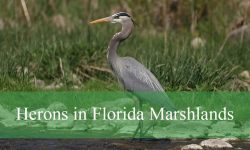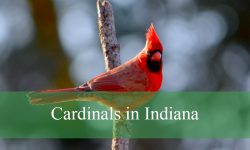Florida is a paradise for birdwatchers, offering the perfect setting to observe some of the most impressive raptors in North America. With its mix of wetlands, forests, coastal plains, and open fields, the state supports an incredible diversity of wildlife. Among the standout species soaring through its skies are the many types of hawks in Florida.
This article introduces 18 remarkable species of hawks in Florida, ranging from widespread year-round residents to rare migratory visitors. Each bird is described in detail, with identification tips, behavioral notes, habitat preferences, and seasonal presence to help you distinguish them in the wild. Stunning images are also included to make recognition even easier.
Exploring the different hawks in Florida provides a deeper appreciation for the state’s natural beauty and avian biodiversity. These sharp-eyed hunters play vital roles in the ecosystem, and learning about them can be both educational and inspiring for anyone interested in wildlife and conservation.
Different Types of Hawks in Florida
Broad-winged Hawk (Buteo platypterus)
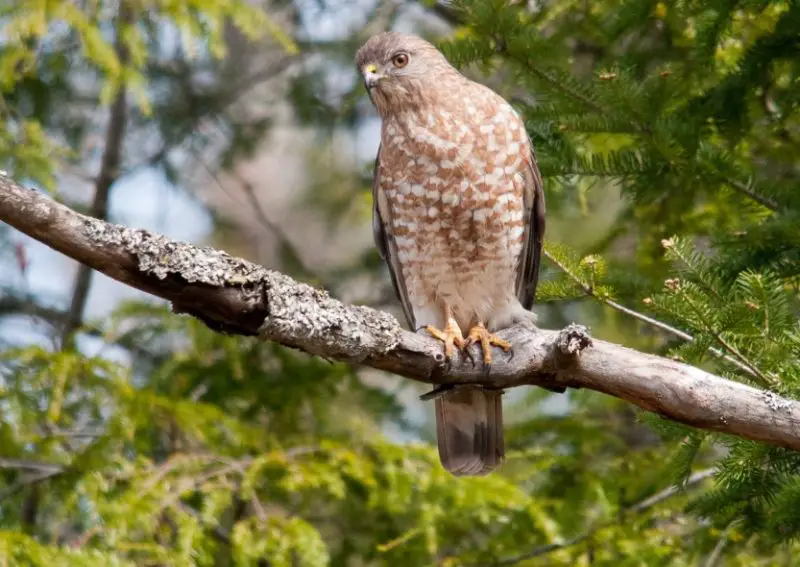
The Broad-winged Hawk is a compact raptor with a short, stocky build and broad, rounded wings. It has a brown back, white underparts with horizontal brown barring, and a distinct black-and-white banded tail. This hawk is smaller than most Buteo hawks but still powerful and agile in flight.
In Florida, the Broad-winged Hawk is typically seen during migration, especially in the spring and fall. It nests in the northeastern United States and Canada but passes through Florida on its way to and from its wintering grounds in Central and South America. During migration, it can be seen in large groups known as “kettles,” circling high on thermal currents.
Its diet includes small mammals, amphibians, insects, and occasionally birds. These hawks prefer forested habitats and are often secretive during the breeding season, making them harder to detect outside of migration. A fascinating fact: during migration, some Broad-winged Hawks travel over 4,000 miles, making one of the longest migrations among raptors in North America.
Short-tailed Hawk (Buteo brachyurus)
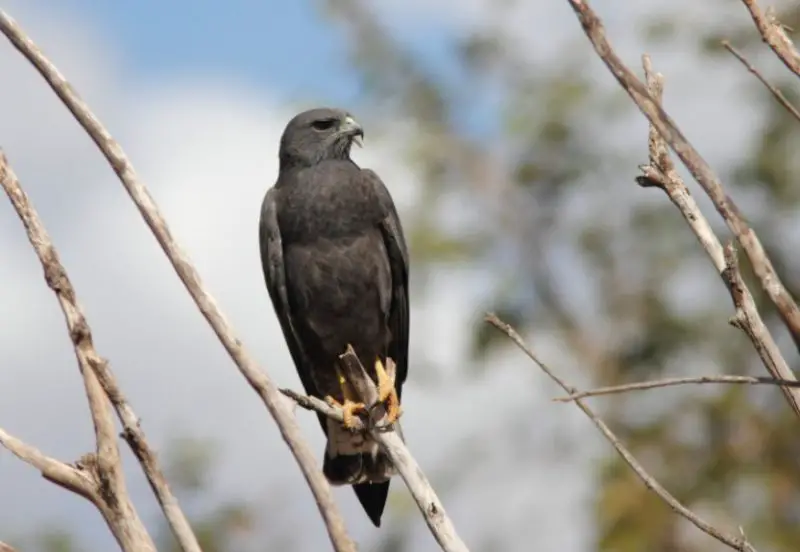
The Short-tailed Hawk is a rare and intriguing raptor found primarily in central and southern Florida. It has a notably short tail, long pointed wings, and comes in two distinct color morphs: a light morph with a white underbody and a dark morph with an almost entirely black body. This hawk is medium-sized and agile, often confused with other raptors due to its variable appearance.
This species is one of the few hawks that breed in Florida, especially in wooded areas near open spaces. It is most commonly seen soaring high over the Everglades, pine flatwoods, and agricultural lands. Its range within the United States is very limited, making Florida a critical area for its presence.
Short-tailed Hawks primarily prey on small birds, often catching them in mid-air using quick and acrobatic flights. They are known for soaring at great heights and diving rapidly to snatch their prey. A fun fact: the dark morph of this hawk is far more common in Florida than in its tropical range, making it a unique regional phenomenon.
Red-tailed Hawk (Buteo jamaicensis)
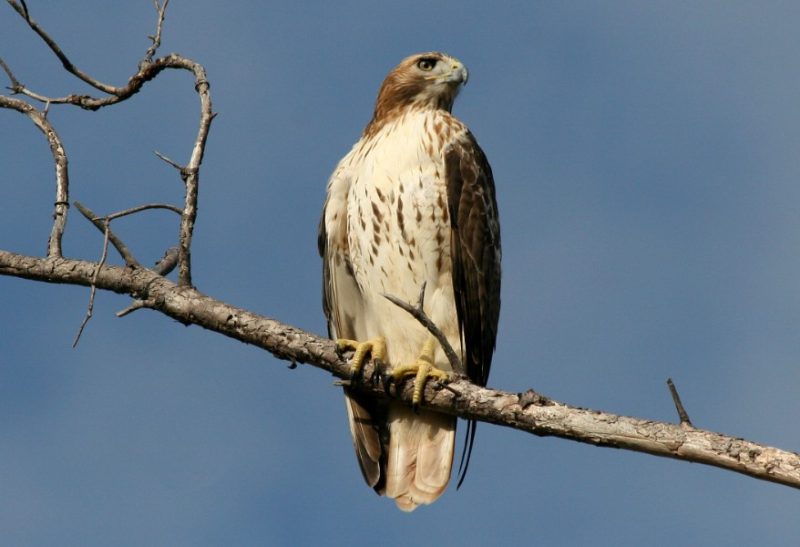
The Red-tailed Hawk is one of the most widespread and recognizable hawks in North America. It is large, with a broad, rounded wingspan and a distinctive reddish-brown tail that gives the species its name. Adults typically have a pale chest and a dark band across the belly, while their sharp eyes and commanding presence make them easy to spot when perched or soaring.
In Florida, Red-tailed Hawks are year-round residents and are commonly found in open habitats such as fields, marsh edges, pine forests, and along roadsides. They are highly adaptable and often take advantage of manmade structures like telephone poles or fence posts for perching and hunting. Their presence is especially noticeable during cooler months when they become more active and visible.
These hawks feed primarily on small to medium-sized mammals such as rabbits, squirrels, and rodents, but they will also eat birds and reptiles when available. Red-tailed Hawks are known for their piercing scream, often used in movies to represent any raptor call. A fun fact: they are one of the few raptors that frequently mate for life and return to the same nesting area year after year.
Red-shouldered Hawk (Buteo lineatus)
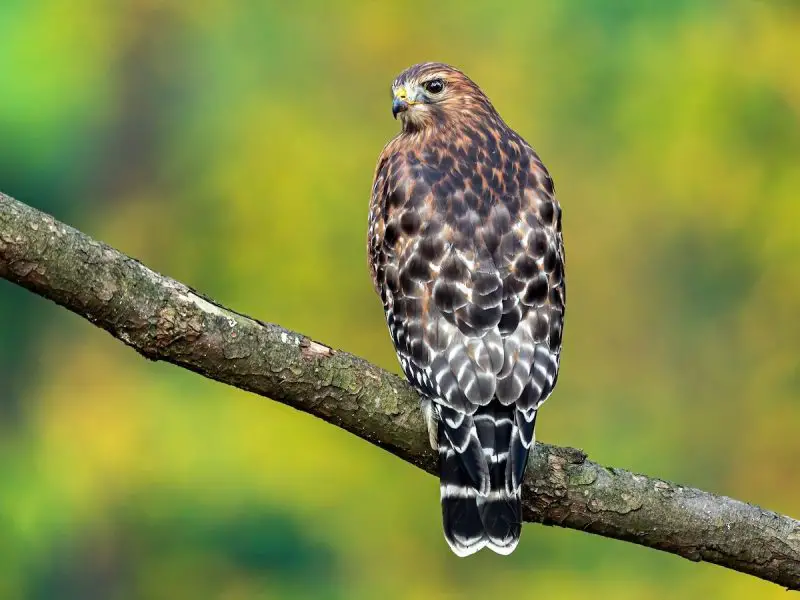
The Red-shouldered Hawk is a striking bird of prey, easily identified by its reddish shoulders, black-and-white checkered wings, and orange-brown underparts. Its loud, distinctive call – a piercing “kee-ah” – is often heard before the bird is even seen, especially during the breeding season.
This species is a year-round resident throughout Florida and is commonly found in forested areas, especially near water sources like swamps, rivers, and marshes. It prefers dense hardwood forests and cypress stands and is often seen perched quietly on low branches, scanning for prey.
Red-shouldered Hawks feed on a variety of animals including frogs, snakes, small mammals, and large insects. They are known for their territorial behavior and often return to the same nest site each year. A fun fact: this species is one of the most vocal of all North American hawks, and its call is often used in movies and TV shows to represent “wilderness” sounds.
Cooper’s Hawk (Accipiter cooperii)
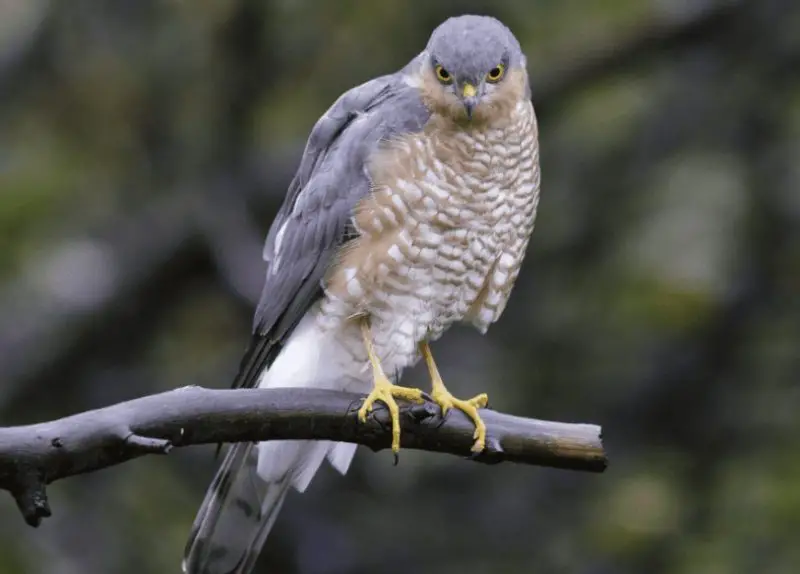
Cooper’s Hawk is a medium-sized accipiter with a sleek body, rounded tail, and short, broad wings. Adults have a steely blue-gray back, reddish barring on the chest, and bright red eyes, giving them a fierce appearance. Juveniles are brown with vertical streaks on the chest and have yellow eyes.
In Florida, Cooper’s Hawks are year-round residents and are often found in wooded areas, suburbs, and even city parks. They are agile flyers, capable of weaving rapidly through dense trees while pursuing prey. Their secretive nature often makes them hard to spot, but they are increasingly adapting to human-altered environments.
Their primary food source is small to medium-sized birds, which they catch in swift, surprise attacks. They will also eat rodents and reptiles when birds are less available. A fun fact: Cooper’s Hawks are known for their high-speed aerial pursuits and are considered one of the most skilled bird-hunting hawks in North America.
Sharp-shinned Hawk (Accipiter striatus)
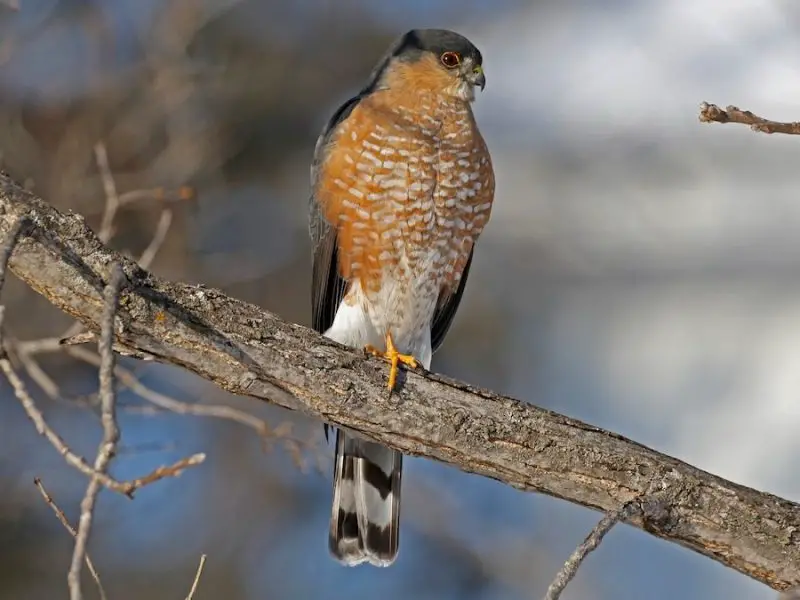
The Sharp-shinned Hawk is the smallest hawk in North America, with males being about the size of a jay. It has short, rounded wings and a long, narrow tail with squared-off tips. Adults feature a bluish-gray back, reddish barring on the chest, and yellow legs, while juveniles display brown streaks and a more muted appearance.
In Florida, Sharp-shinned Hawks are most commonly seen during migration in the spring and fall, though some may overwinter in the state. They prefer dense forests and wooded edges where they can maneuver quickly between trees. These hawks are stealthy and elusive, making them harder to observe unless they are soaring or actively hunting.
Their primary prey consists of small birds, such as sparrows and warblers, which they capture with sudden bursts of speed. They are agile flyers, often surprising their prey with lightning-quick strikes. A fun fact: despite their small size, Sharp-shinned Hawks are bold hunters and have even been known to pursue prey larger than themselves.
Northern Harrier (Circus hudsonius)
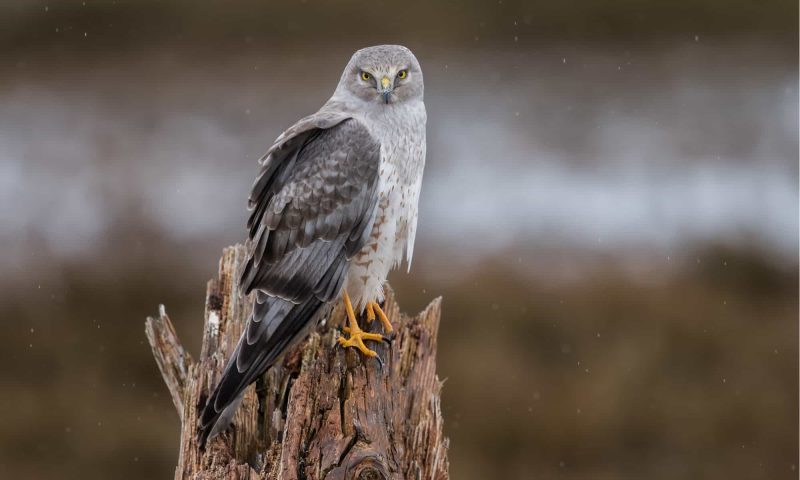
The Northern Harrier is a slender, medium-sized raptor known for its owl-like facial disk and low gliding flight. Males are pale gray with black wingtips, while females are brown with streaked underparts. Both sexes have a distinct white rump patch that makes them easy to identify from behind.
In Florida, Northern Harriers are winter visitors, typically seen from late fall through early spring. They favor open habitats such as marshes, prairies, and grassy fields, where they fly low over the ground in search of prey. Their unique hunting style involves coursing close to the ground and using their keen hearing as well as sight to locate food.
Their diet includes small mammals, birds, and amphibians, especially voles and mice. Unlike most hawks, Northern Harriers rely heavily on auditory cues, much like owls. A fun fact: they are the only harrier species found in North America and are sometimes called “marsh hawks” because of their strong association with wetlands.
Swainson’s Hawk (Buteo swainsoni)
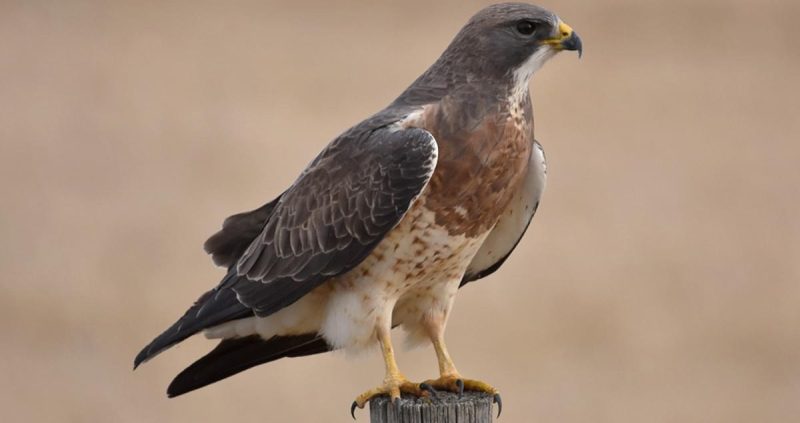
Swainson’s Hawk is a graceful, long-winged raptor known for its slim build and pointed wingtips. Adults typically have a light-colored underside with a contrasting dark bib on the chest, and some individuals may appear nearly all dark. This hawk is built for long-distance flight and is often seen soaring on thermals.
In Florida, Swainson’s Hawks are considered rare but regular migrants, most likely to be spotted during spring and fall migration. They generally pass through open areas such as fields and pastures on their way between their breeding grounds in the western U.S. and their wintering grounds in South America. Their presence is more common in the Panhandle and central parts of the state.
Swainson’s Hawks feed mainly on insects like grasshoppers and dragonflies during migration, but they also hunt rodents and small birds. One fun fact: this species is known for its astonishing migration journey, traveling up to 14,000 miles round trip each year—one of the longest migrations of any raptor in the Western Hemisphere.
Zone-tailed Hawk (Buteo albonotatus)

The Zone-tailed Hawk is a striking black raptor with bold white bands across its tail. It has long, narrow wings and a flight style that closely resembles that of the Turkey Vulture. This mimicry allows it to blend in with vultures as it searches for unsuspecting prey from above.
This species is very rare in Florida, typically considered an occasional or accidental visitor. When spotted, it is most often during spring migration or in the extreme southern parts of the state. Its preferred habitat includes arid canyons and mountainous regions in the western U.S., but it occasionally strays eastward.
Zone-tailed Hawks prey on small mammals, birds, and reptiles, often using surprise attacks while gliding low or dropping suddenly from the sky. A fun fact: their resemblance to vultures helps them avoid detection by prey, making them effective stealth hunters. Their dark plumage and unique flight behavior make any Florida sighting a special event for birdwatchers.
Rough-legged Hawk (Buteo lagopus)

The Rough-legged Hawk is a large, broad-winged hawk known for its feathered legs that extend all the way to the toes—a unique trait among American raptors. It has a variable appearance but is generally light underneath with a dark belly band and dark patches at the wrist of the wings. It can also occur in a dark morph that appears chocolate-brown.
This species breeds in the Arctic tundra and migrates south during winter. In Florida, Rough-legged Hawks are considered rare winter visitors, most likely seen in open fields and farmlands in the northern parts of the state. Their presence is highly irregular and usually tied to harsh winters farther north that push them beyond their normal range.
Rough-legged Hawks feed on small mammals, especially voles, lemmings, and mice. They often hover in place while scanning the ground, a behavior more typical of kestrels than large hawks. A fun fact: they are one of the few hawk species that exhibit hovering flight and are specially adapted to cold environments with heavily feathered legs for insulation.
Ferruginous Hawk (Buteo regalis)
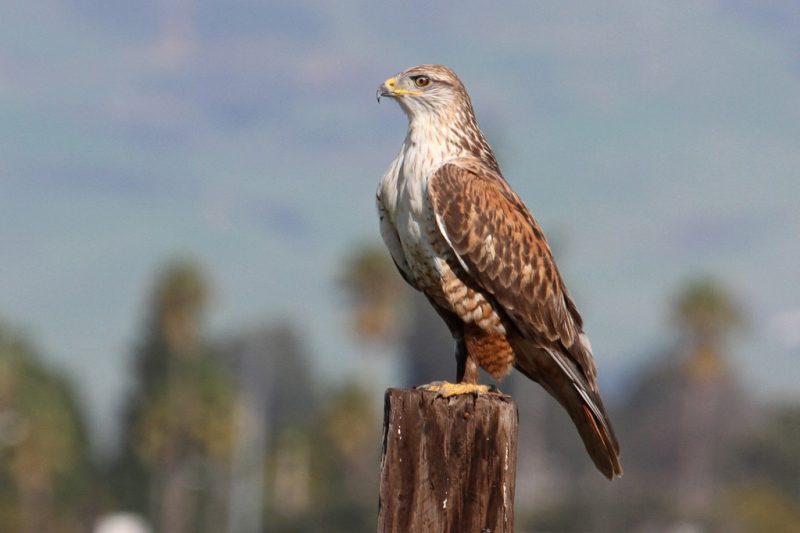
The Ferruginous Hawk is the largest hawk in North America, with a wingspan reaching up to 56 inches. It has a pale head, rufous-colored legs, and large, broad wings. The light morph has a white underbelly with reddish-brown markings, while the dark morph is chocolate brown overall with lighter flight feathers.
This species is native to the open plains and deserts of the western United States and Canada. In Florida, it is a very rare visitor, typically spotted only during winter months and primarily in the Panhandle or other open, agricultural regions. Its appearance in the state is considered accidental or irregular.
Ferruginous Hawks feed mainly on small mammals such as ground squirrels, prairie dogs, and rabbits. They often perch on high vantage points or soar over open land to hunt. A fun fact: their name “ferruginous” refers to the rust-colored feathers on their legs and back, giving them a distinctive look among Buteos.
Harlan’s Hawk (Buteo jamaicensis harlani)
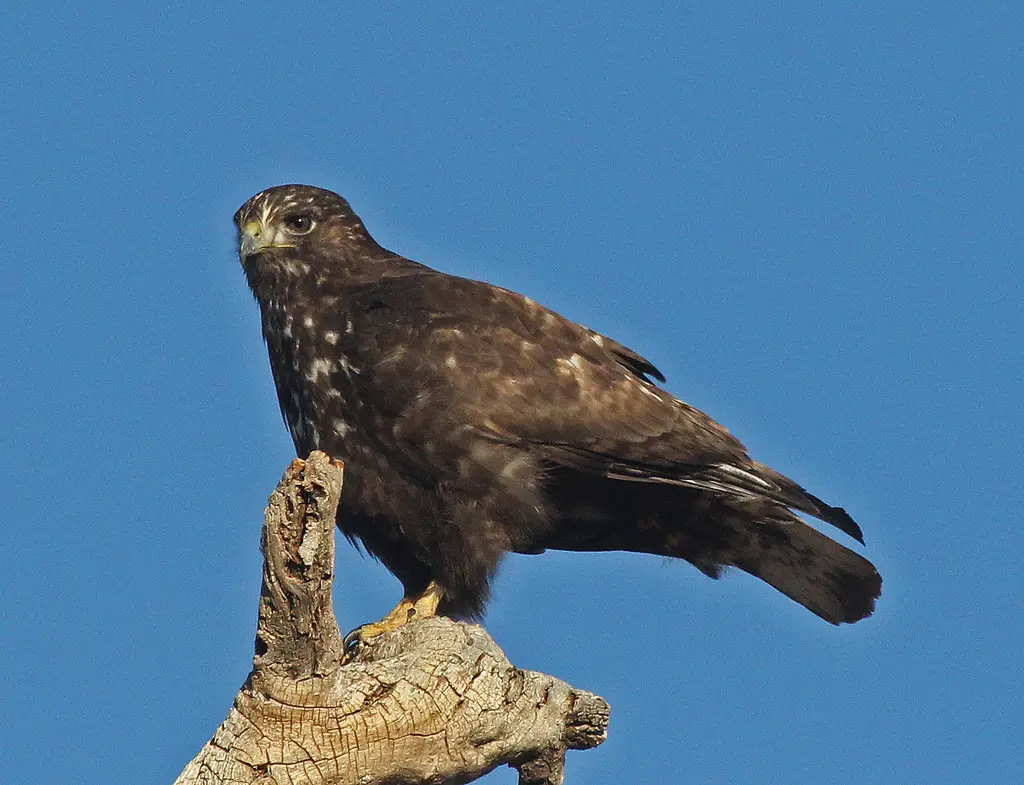
Harlan’s Hawk is a dark-colored subspecies of the Red-tailed Hawk. It exhibits a wide range of plumage variation but is generally darker than other Red-tailed Hawks, often appearing nearly black or mottled gray and white. It retains the classic broad wings and short, red-tinged tail characteristic of its species.
Although native to Alaska and northwestern Canada, Harlan’s Hawk migrates south in winter, and very occasionally, individuals make their way into Florida. These sightings are rare and usually limited to the northern part of the state during colder months. They tend to inhabit open fields and woodland edges, similar to other Red-tailed Hawks.
Like its relatives, Harlan’s Hawk preys on rodents, birds, and reptiles, often hunting from perches or while soaring. A fun fact: it was once considered a separate species due to its dramatic appearance but is now classified as a Red-tailed Hawk subspecies. Birders eagerly watch for Harlan’s Hawks during hawk migration seasons because of their striking looks.
Great Black Hawk (Buteogallus urubitinga)
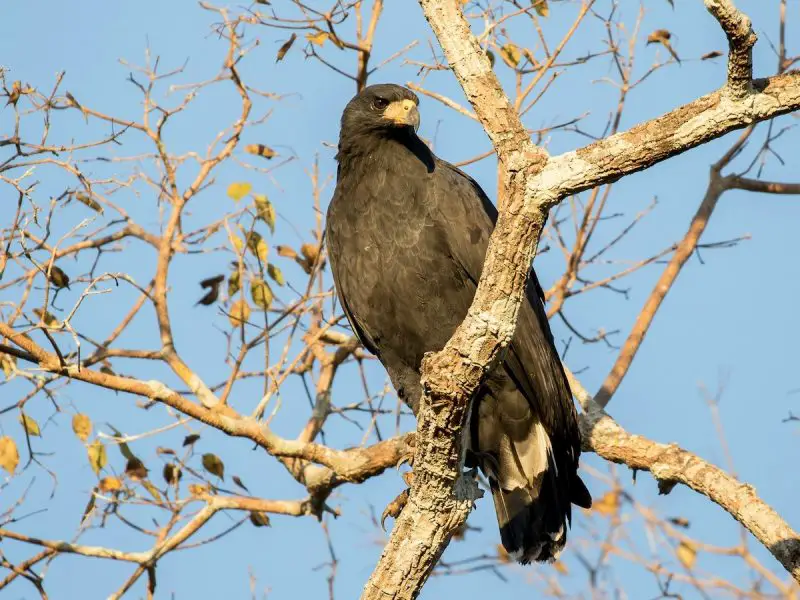
The Great Black Hawk is a large tropical raptor with glossy black plumage, broad wings, and a long tail marked by a single white band. It resembles the Common Black Hawk but is notably larger and less frequently seen in the U.S. Its powerful beak and legs give it an imposing presence.
This species is typically found in Central and South America, where it inhabits tropical forests, mangroves, and river valleys. In Florida, the Great Black Hawk is an extreme rarity, with only one confirmed individual documented in 2018–2019 in the northern part of the state. That bird generated national attention among birders and was sadly later found injured and euthanized.
Great Black Hawks feed on reptiles, amphibians, fish, and small mammals, often foraging along riverbanks and coastal areas. A fascinating fact: the 2018 sighting in Florida marked the first time this species was confirmed in the continental U.S., making it one of the most extraordinary avian vagrants in recent memory.
Common Black Hawk (Buteogallus anthracinus)

The Common Black Hawk is a striking raptor with dark black plumage and a bold white band across its short, broad tail. Its appearance is stocky, and it has wide wings adapted for soaring in humid environments. The bird’s call is a high-pitched, whistling cry, often heard during territorial displays.
This species is primarily found in the southwestern United States, Mexico, and Central America, where it inhabits riparian zones and forested waterways. Though extremely rare in Florida, there have been a few documented sightings, typically near coastal wetlands or river systems. These are considered vagrant individuals that have strayed far from their typical range.
Common Black Hawks feed on amphibians, reptiles, fish, and small mammals. They often perch silently near water sources, waiting to ambush prey. A fun fact: juveniles are heavily streaked and resemble immature Red-shouldered Hawks, making identification challenging for birders unfamiliar with their subtle differences.
Crane Hawk (Geranospiza caerulescens)
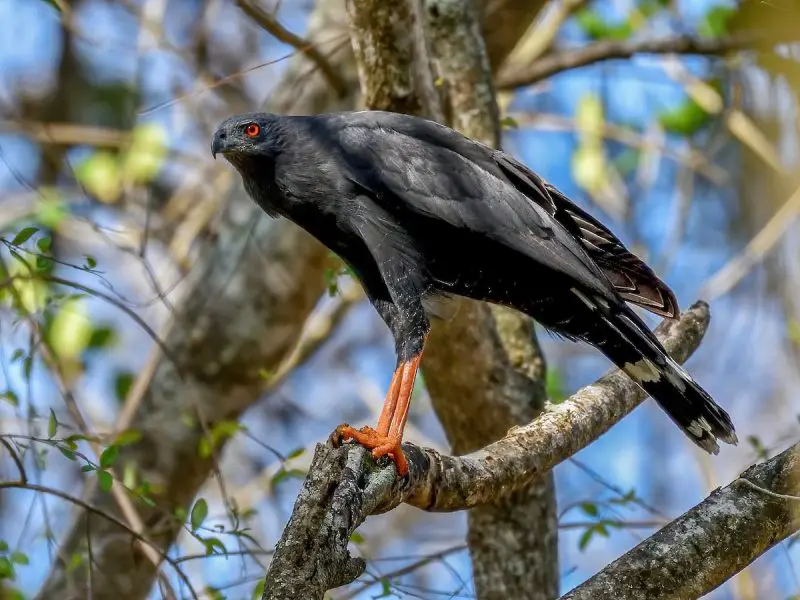
The Crane Hawk is a sleek and slender raptor known for its long legs and unique foraging technique. Its body is dark gray with a pale rump and a broad tail with white bands. One of its most distinctive features is its long, flexible legs, which allow it to reach into tree cavities and bromeliads to extract prey.
Although native to Central and South America, the Crane Hawk has been recorded on rare occasions in southern Florida, especially within the Everglades and other wetland preserves. These sightings are exceptional and likely involve birds displaced by weather or ecological pressures.
Crane Hawks feed on insects, small reptiles, amphibians, and bird nestlings. They are highly adaptable hunters that move methodically through forest canopies. A fascinating behavior: they can double-joint their legs to probe into tight crevices, a rare trait among raptors.
Gray Hawk (Buteo plagiatus)
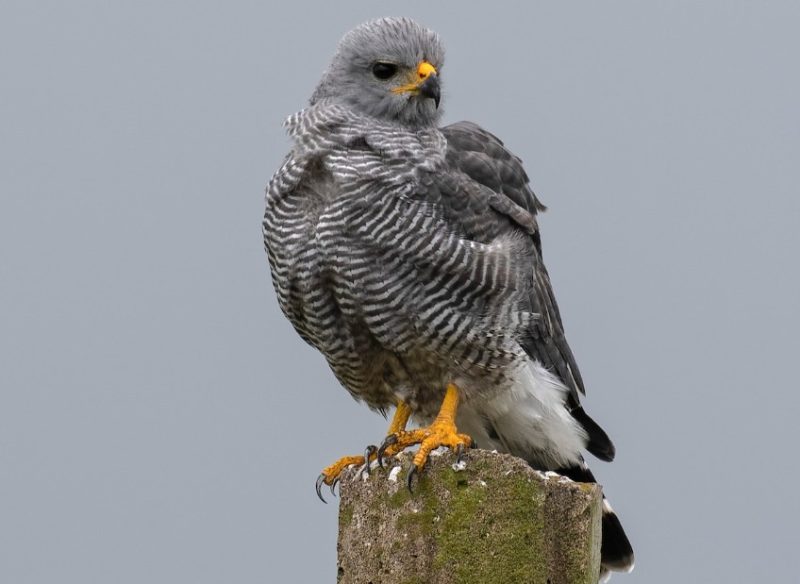
The Gray Hawk is a medium-sized raptor with light gray plumage, finely barred underparts, and a tail marked with broad white and black bands. Its small, rounded head and short tail give it a compact appearance, while its loud, descending whistle is often heard before the bird is seen.
Commonly found in the southwestern U.S. and Mexico, the Gray Hawk inhabits riparian woodlands and lowland valleys. In Florida, it is a very rare visitor, most likely seen during migration periods or as an accidental vagrant. Sightings are typically limited to southern regions of the state.
Gray Hawks primarily prey on lizards and small birds, scanning from perches before swooping down swiftly to catch prey. A fun fact: during breeding season, these hawks perform aerial courtship displays, including soaring and calling, often in pairs.
Harris’s Hawk (Parabuteo unicinctus)
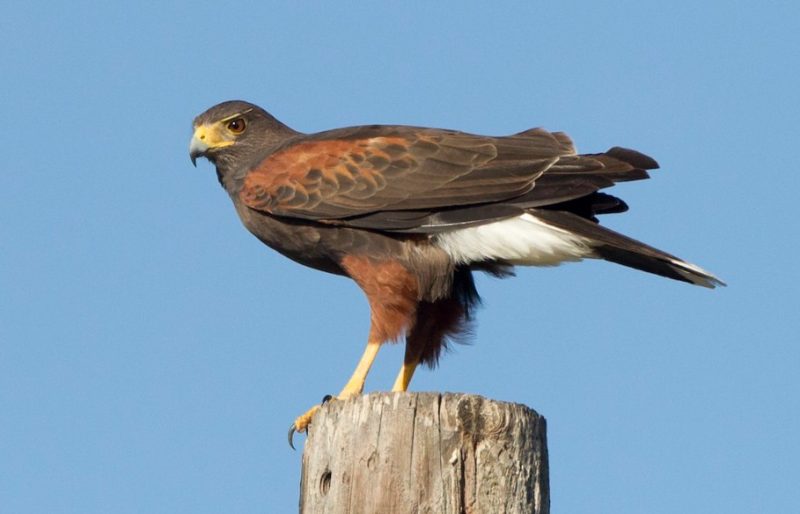
The Harris’s Hawk is a striking bird with dark brown plumage, reddish-brown shoulders and thighs, and a white-tipped tail. It has long legs and a broad wingspan, giving it a powerful, agile flight style. Its alert yellow eyes and facial skin are also distinctive features.
Although this species naturally occurs in the deserts and scrublands of the southwestern U.S. and Latin America, a few individuals have been spotted in Florida. These are often escapees from falconry or breeding programs, but occasionally, wild birds may wander far from their normal range.
Harris’s Hawks are famous for their social behavior—they hunt in cooperative groups, using teamwork to flush and trap prey like rabbits and quail. This social strategy is extremely rare among raptors. A fun fact: their group dynamics resemble those of wolf packs, with individuals taking turns in roles during a hunt.
White-tailed Hawk (Geranoaetus albicaudatus)
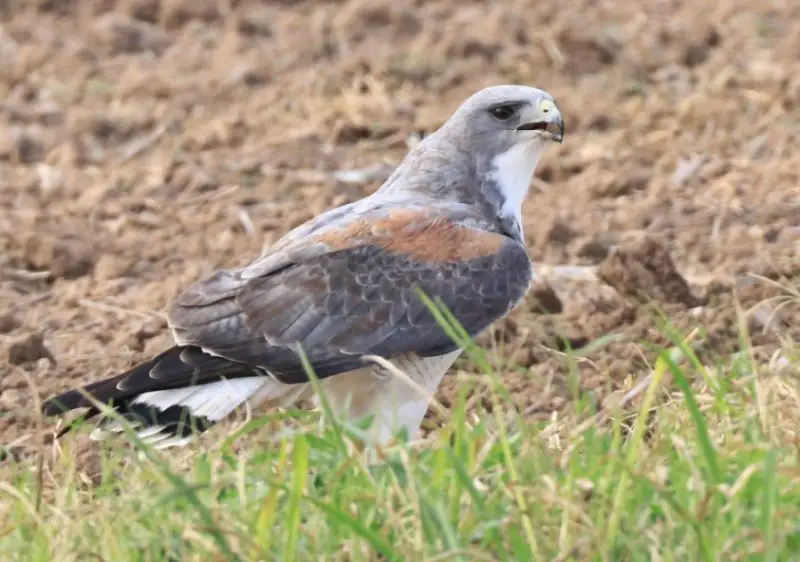
The White-tailed Hawk is a large raptor with a light gray upper body, white underparts, and a distinctive white tail marked by a bold black subterminal band. It has long, broad wings and a regal flight posture, often soaring high in open skies.
Native to southern Texas, Central America, and parts of South America, the White-tailed Hawk is rarely observed in Florida. When it does appear, it is typically as a wanderer or possible vagrant, especially during the fall or winter months. Sightings are most likely in open, dry grasslands or coastal prairies.
This hawk feeds on small mammals, reptiles, birds, and large insects. It hunts by soaring over open areas or from elevated perches. A fun fact: unlike many hawks, it sometimes feeds on carrion and is known to visit recently burned fields to catch fleeing prey.

